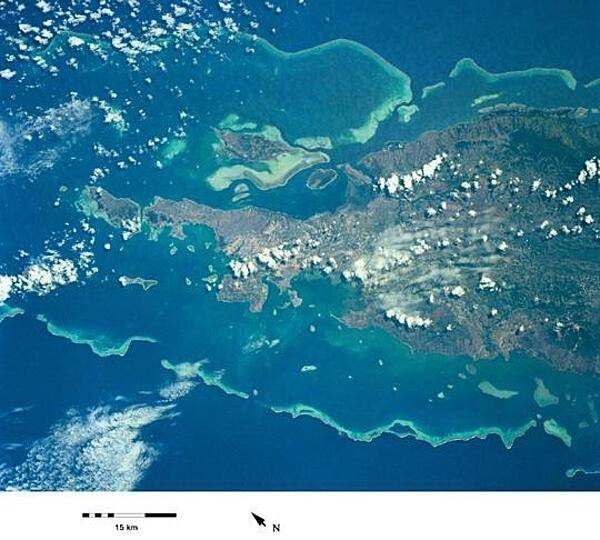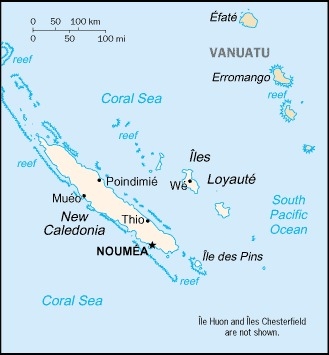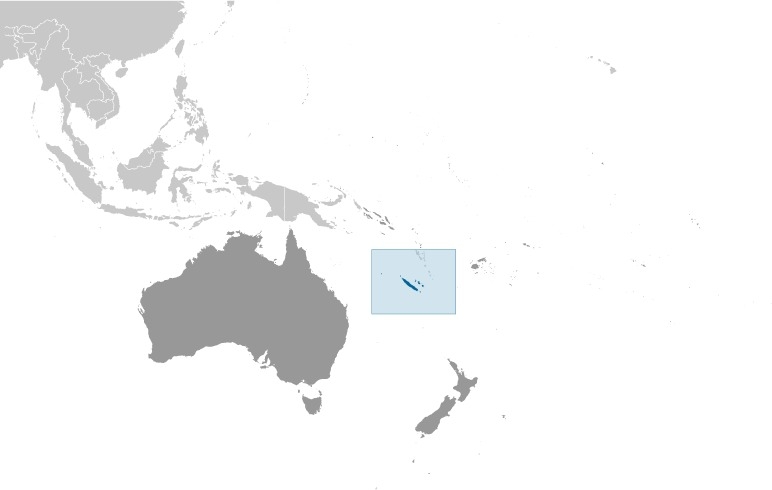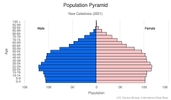New Caledonia
Introduction
Background
The first humans settled in New Caledonia around 1600 B.C. The Lapita were skilled navigators and evidence of their pottery around the Pacific has served as a guide for understanding human expansion in the region. Successive waves of migrants from other islands in Melanesia intermarried with the Lapita, giving rise to the Kanak ethnic group considered indigenous to New Caledonia. British explorer James COOK was the first European to visit New Caledonia in 1774, giving it the Latin name for Scotland. Missionaries first landed in New Caledonia in 1840. In 1853, France annexed New Caledonia to preclude any British attempt. France declared it a penal colony in 1864 and sent more than 20,000 prisoners to New Caledonia in the ensuing three decades.
Nickel was discovered in 1864 and French prisoners were directed to mine it. France brought in indentured servants and enslaved labor from elsewhere in Southeast Asia to work the mines, blocking Kanaks from accessing the most profitable part of the local economy. In 1878, High Chief ATAI led a rebellion against French rule. The Kanaks were relegated to reservations, leading to periodic smaller uprisings and culminating in a large revolt in 1917 that was brutally suppressed by colonial authorities. During World War II, New Caledonia became an important base for Allied troops, and the US moved its South Pacific headquarters to the island in 1942. Following the war, New Caledonia was made an overseas territory and French citizenship was granted to all inhabitants in 1953, thereby permitting the Kanaks to move off the reservations.
The Kanak nationalist movement began in the 1950s but most voters chose to remain a territory in an independence referendum in 1958. The European population of New Caledonia boomed in the 1970s with a renewed focus on nickel mining, reigniting Kanak nationalism. Key Kanak leaders were assassinated in the early 1980s, leading to escalating violence and dozens of fatalities. The Matignon Accords of 1988 provided for a 10-year transition period. The Noumea Accord of 1998 transferred an increasing amount of governing responsibility from France to New Caledonia over a 20-year period and provided for three independence referenda. In the first held in 2018, voters rejected independence by 57 to 43 percent; in the second held in 2020, voters rejected independence 53 to 47 percent. A third referendum is planned for December 2021. In February 2021, pro-independence parties gained a majority in the New Caledonian Government for the first time.
Visit the Definitions and Notes page to view a description of each topic.
Geography
Location
Oceania, islands in the South Pacific Ocean, east of Australia
Geographic coordinates
21 30 S, 165 30 E
Map references
Oceania
Area - comparative
slightly smaller than New Jersey
Land boundaries
total: 0 km
Coastline
2,254 km
Maritime claims
territorial sea: 12 nm
exclusive economic zone: 200 nm
Climate
tropical; modified by southeast trade winds; hot, humid
Terrain
coastal plains with interior mountains
Elevation
highest point: Mont Panie 1,628 m
lowest point: Pacific Ocean 0 m
Natural resources
nickel, chrome, iron, cobalt, manganese, silver, gold, lead, copper
Land use
agricultural land: 10.4% (2018 est.)
arable land: 0.4% (2018 est.)
permanent crops: 0.2% (2018 est.)
permanent pasture: 9.8% (2018 est.)
forest: 45.9% (2018 est.)
other: 43.7% (2018 est.)
Irrigated land
100 sq km (2012)
Population distribution
most of the populace lives in the southern part of the main island, in and around the capital of Noumea
Natural hazards
cyclones, most frequent from November to March
volcanism: Matthew and Hunter Islands are historically active
Geography - note
consists of the main island of New Caledonia (one of the largest in the Pacific Ocean), the archipelago of Iles Loyaute, and numerous small, sparsely populated islands and atolls
People and Society
Nationality
noun: New Caledonian(s)
adjective: New Caledonian
Ethnic groups
Kanak 39.1%, European 27.1%, Wallisian, Futunian 8.2%, Tahitian 2.1%, Indonesian 1.4%, Ni-Vanuatu 1%, Vietnamese 0.9%, other 17.7%, unspecified 2.5% (2014 est.)
Languages
French (official), 33 Melanesian-Polynesian dialects
major-language sample(s):
The World Factbook, une source indispensable d'informations de base. (French)
The World Factbook, the indispensable source for basic information.
Religions
Christian 85.2%, Muslim 2.8%, other 1.6%, unaffiliated 10.4% (2020 est.)
Age structure
0-14 years: 21.74% (male 32,227/female 30,819)
15-24 years: 15.63% (male 23,164/female 22,163)
25-54 years: 43.73% (male 63,968/female 62,856)
55-64 years: 9.06% (male 12,700/female 13,568)
65 years and over: 9.84% (male 12,552/female 15,992) (2020 est.)
Dependency ratios
total dependency ratio: 46.6
youth dependency ratio: 32.4
elderly dependency ratio: 14.2
potential support ratio: 7 (2020 est.)
Median age
total: 32.9 years
male: 32.1 years
female: 33.7 years (2020 est.)
Net migration rate
3.71 migrant(s)/1,000 population (2021 est.)
note: there has been steady emigration from Wallis and Futuna to New Caledonia
Population distribution
most of the populace lives in the southern part of the main island, in and around the capital of Noumea
Urbanization
urban population: 71.9% of total population (2021)
rate of urbanization: 1.72% annual rate of change (2020-25 est.)
Major urban areas - population
198,000 NOUMEA (capital) (2018)
Sex ratio
at birth: 1.05 male(s)/female
0-14 years: 1.05 male(s)/female
15-24 years: 1.05 male(s)/female
25-54 years: 1.02 male(s)/female
55-64 years: 0.94 male(s)/female
65 years and over: 0.78 male(s)/female
total population: 1 male(s)/female (2020 est.)
Infant mortality rate
total: 5.08 deaths/1,000 live births
male: 6.07 deaths/1,000 live births
female: 4.05 deaths/1,000 live births (2021 est.)
Life expectancy at birth
total population: 78.59 years
male: 74.66 years
female: 82.71 years (2021 est.)
Drinking water source
improved: total: 100% of population
unimproved: total: 0% of population (2017 est.)
Physicians density
2.22 physicians/1,000 population (2009)
Sanitation facility access
improved: total: 100% of population
unimproved: total: 0% of population (2017 est.)
Major infectious diseases
degree of risk: high (2020)
food or waterborne diseases: bacterial diarrhea
vectorborne diseases: malaria
Literacy
definition: age 15 and over can read and write
total population: 96.9%
male: 97.3%
female: 96.5% (2015)
Unemployment, youth ages 15-24
total: 38.4%
male: 37.1%
female: 40% (2014 est.)
Environment
Environment - current issues
preservation of coral reefs; prevention of invasive species; limiting erosion caused by nickel mining and forest fires
Air pollutants
carbon dioxide emissions: 5.33 megatons (2016 est.)
Climate
tropical; modified by southeast trade winds; hot, humid
Land use
agricultural land: 10.4% (2018 est.)
arable land: 0.4% (2018 est.)
permanent crops: 0.2% (2018 est.)
permanent pasture: 9.8% (2018 est.)
forest: 45.9% (2018 est.)
other: 43.7% (2018 est.)
Urbanization
urban population: 71.9% of total population (2021)
rate of urbanization: 1.72% annual rate of change (2020-25 est.)
Major infectious diseases
degree of risk: high (2020)
food or waterborne diseases: bacterial diarrhea
vectorborne diseases: malaria
Waste and recycling
municipal solid waste generated annually: 108,157 tons (2016 est.)
Government
Country name
conventional long form: Territory of New Caledonia and Dependencies
conventional short form: New Caledonia
local long form: Territoire des Nouvelle-Caledonie et Dependances
local short form: Nouvelle-Caledonie
etymology: British explorer Captain James COOK discovered and named New Caledonia in 1774; he used the appellation because the northeast of the island reminded him of Scotland (Caledonia is the Latin designation for Scotland)
Government type
parliamentary democracy (Territorial Congress); an overseas collectivity of France
Dependency status
special collectivity (or a sui generis collectivity) of France since 1998; note - independence referenda took place on 4 November 2018, 4 October 2020, and 12 December 2021 with a majority voting in each case to reject independence in favor of maintaining the status quo; an 18-month transition period is now in place (ending 30 June 2023), during which a referendum on the new status of New Caledonia within France will take place
Capital
name: Noumea
geographic coordinates: 22 16 S, 166 27 E
time difference: UTC+11 (16 hours ahead of Washington, DC, during Standard Time)
etymology: established in 1854 as Port-de-France, the settlement was renamed Noumea in 1866, in order to avoid any confusion with Fort-de-France in Martinique; the New Caledonian language of Ndrumbea (also spelled Ndumbea, Dubea, and Drubea) spoken in the area gave its name to the capital city, Noumea, as well as to the neighboring town (suburb) of Dumbea
Administrative divisions
3 provinces; Province Iles (Islands Province), Province Nord (North Province), and Province Sud (South Province)
Independence
none (overseas collectivity of France); note - in three independence referenda, on 4 November 2018, 4 October 2020, and 12 December 2021, the majority voted to reject independence in favor of maintaining the status quo; an 18-month transition period is now in place (ending 30 June 2023), during which a referendum on the new status of New Caledonia within France will take place
National holiday
Fete de la Federation, 14 July (1790); note - the local holiday is New Caledonia Day, 24 September (1853)
Constitution
history: 4 October 1958 (French Constitution with changes as reflected in the Noumea Accord of 5 May 1998)
amendments: French constitution amendment procedures apply
Legal system
civil law system based on French civil law
Citizenship
see France
Suffrage
18 years of age; universal
Executive branch
chief of state: President Emmanuel MACRON (since 14 May 2017); represented by High Commissioner Laurent PREVOST (since 5 August 2019)
head of government: President of the Government Thierry SANTA (since 9 July 2019); Temporary Vice President Gilbert TUIENON (since 9 July 2019); note - Temporary Vice President Gilbert TUIENON was elected so that the new government could take over; Philippe GERMAIN' s government remained caretaker government until the new government was settled
cabinet: Cabinet elected from and by the Territorial Congress
elections/appointments: French president directly elected by absolute majority popular vote in 2 rounds if needed for a 5-year term (eligible for a second term); high commissioner appointed by the French president on the advice of the French Ministry of Interior; president of New Caledonia elected by Territorial Congress for a 5-year term (no term limits); election last held on 13 June 2017 (next to be held in 2022)
election results: Thierry SANTA elected president by Territorial Congress with 6 votes out of 11
Legislative branch
description: unicameral Territorial Congress or Congrès du Territoire (54 seats; members indirectly selected proportionally by the partisan makeup of the 3 Provincial Assemblies or Assemblés Provinciales; members of the 3 Provincial Assemblies directly elected by proportional representation vote; members serve 5-year terms); note - the Customary Senate is the assembly of the various traditional councils of the Kanaks, the indigenous population, which rules on laws affecting the indigenous population
New Caledonia indirectly elects 2 members to the French Senate by an electoral colleges for a 6-year term with one seat renewed every 3 years and directly elects 2 members to the French National Assembly by absolute majority vote in 2 rounds if needed for a 5-year term
elections:
Territorial Congress - last held on 12 May 2019 (next to be held in May 2024)
French Senate - election last held in September 2019 (next to be held not later than 2021)
French National Assembly - election last held on 11 and 18 June 2017 (next to be held by June 2022)
election results:
Territorial Congress - percent of vote by party - N/A; seats by party -Future With Confidence 18, UNI 9, UC 9, CE 7, FLNKS 6, Oceanic Awakening 3, PT 1, LKS 1 (Anti-Independence 28, Pro-Independence 26); composition - NA
representation in French Senate - NA
representation in French National Assembly - NA
French Senate - percent of vote by party - NA; seats by party - UMP 2
French National Assembly - percent of vote by party - NA; seats by party - CE 2
Judicial branch
highest courts: Court of Appeal in Noumea or Cour d'Appel; organized into civil, commercial, social, and pre-trial investigation chambers; court bench normally includes the court president and 2 counselors); Administrative Court (number of judges NA); note - final appeals beyond the Court of Appeal are referred to the Court of Cassation or Cour de Cassation (in Paris); final appeals beyond the Administrative Court are referred to the Administrative Court of Appeal (in Paris)
judge selection and term of office: judge appointment and tenure based on France's judicial system
subordinate courts: Courts of First Instance include: civil, juvenile, commercial, labor, police, criminal, assizes, and also a pre-trial investigation chamber; Joint Commerce Tribunal; administrative courts
Political parties and leaders
Build Our Rainbow Nation
Caledonia Together or CE [Philippe GERMAIN]
Caledonian Union or UC [Daniel GOA]
Future Together (l'Avenir Ensemble) [Harold MARTIN]
Kanak Socialist Front for National Liberation or FLNKS (alliance includes PALIKA, UNI, UC, and UPM) [Victor TUTUGORO]
Labor Party (Parti Travailliste) or PT [Louis Kotra UREGEI]
National Union for Independence (Union Nationale pour l'Independance) or UNI
Party of Kanak Liberation (Parti de Liberation Kanak) or PALIKA [Paul NEAOUTYINE]
Socialist Kanak Liberation or LKS [Nidoish NAISSELINE]
The Republicans (formerly The Rally or UMP) [interim leader Thierry SANTA]
Union for Caledonia in France
International organization participation
ITUC (NGOs), PIF (associate member), SPC, UPU, WFTU (NGOs), WMO
Diplomatic representation in the US
none (overseas territory of France)
Diplomatic representation from the US
embassy: none (overseas territory of France)
Flag description
New Caledonia has two official flags; alongside the flag of France, the Kanak (indigenous Melanesian) flag has equal status; the latter consists of three equal horizontal bands of blue (top), red, and green; a large yellow disk - diameter two-thirds the height of the flag - shifted slightly to the hoist side is edged in black and displays a black fleche faitiere symbol, a native rooftop adornment
National symbol(s)
fleche faitiere (native rooftop adornment), kagu bird; national colors: gray, red
National anthem
name: "Soyons unis, devenons freres" (Let Us Be United, Let Us Become Brothers)
lyrics/music: Chorale Melodia (a local choir)
note: adopted 2008; contains a mixture of lyrics in both French and Nengone (an indigenous language); as a self-governing territory of France, in addition to the local anthem, "La Marseillaise" is official (see France)
Economy
Economic overview
New Caledonia has 11% of the world's nickel reserves, representing the second largest reserves on the planet. Only a small amount of the land is suitable for cultivation, and food accounts for about 20% of imports. In addition to nickel, substantial financial support from France - equal to more than 15% of GDP - and tourism are keys to the health of the economy.
With the gradual increase in the production of two new nickel plants in 2015, average production of metallurgical goods stood at a record level of 94 thousand tons. However, the sector is exposed to the high volatility of nickel prices, which have been in decline since 2016. In 2017, one of the three major mining firms on the island, Vale, put its operations up for sale, triggering concerns of layoffs ahead of the 2018 independence referendum.
Real GDP (purchasing power parity)
$11.11 billion (2017 est.)
$10.89 billion (2016 est.)
$10.77 billion (2015 est.)
note: data are in 2015 dollars
Real GDP growth rate
2% (2017 est.)
1.1% (2016 est.)
3.2% (2015 est.)
Real GDP per capita
$31,100 (2015 est.)
$32,100 (2014 est.)
$29,800 (2012 est.)
GDP (official exchange rate)
$9.77 billion (2017 est.)
GDP - composition, by sector of origin
agriculture: 1.4% (2017 est.)
industry: 26.4% (2017 est.)
services: 72.1% (2017 est.)
GDP - composition, by end use
household consumption: 64.3% (2017 est.)
government consumption: 24% (2017 est.)
investment in fixed capital: 38.4% (2017 est.)
investment in inventories: 0% (2017 est.)
exports of goods and services: 18.7% (2017 est.)
imports of goods and services: -45.5% (2017 est.)
Agricultural products
coconuts, vegetables, maize, fruit, beef, pork, potatoes, bananas, eggs, yams
Industries
nickel mining and smelting
Labor force - by occupation
agriculture: 2.7%
industry: 22.4%
services: 74.9% (2010)
Population below poverty line
17% (2008)
Household income or consumption by percentage share
lowest 10%: NA
highest 10%: NA
Budget
revenues: 1.995 billion (2015 est.)
expenditures: 1.993 billion (2015 est.)
Fiscal year
calendar year
Current account balance
-$1.469 billion (2014 est.)
-$1.861 billion (2013 est.)
Exports - partners
China 59%, South Korea 14%, Japan 11% (2019)
Exports - commodities
iron alloys, nickel, cobalt, carbonates, essential oils (2019)
Imports - partners
France 43%, Australia 12%, Singapore 12%, China 6% (2019)
Imports - commodities
refined petroleum, aircraft, coal, cars, packaged medicines (2019)
Debt - external
$112 million (31 December 2013 est.)
$79 million (31 December 1998 est.)
Exchange rates
Comptoirs Francais du Pacifique francs (XPF) per US dollar -
110.2 (2017 est.)
107.84 (2016 est.)
107.84 (2015 est.)
89.85 (2013 est.)
90.56 (2012 est.)
Unemployment, youth ages 15-24
total: 38.4%
male: 37.1%
female: 40% (2014 est.)
Energy
Electricity access
electrification - total population: 100% (2020)
Electricity - installed generating capacity
996,200 kW (2016 est.)
country comparison to the world: 128Electricity - from fossil fuels
87% of total installed capacity (2016 est.)
country comparison to the world: 64Electricity - from nuclear fuels
0% of total installed capacity (2017 est.)
country comparison to the world: 153Electricity - from hydroelectric plants
8% of total installed capacity (2017 est.)
country comparison to the world: 123Electricity - from other renewable sources
6% of total installed capacity (2017 est.)
country comparison to the world: 100Refined petroleum products - consumption
20,000 bbl/day (2016 est.)
country comparison to the world: 142Communications
Telephones - fixed lines
total subscriptions: 77,719 (2018)
subscriptions per 100 inhabitants: 28.67 (2018 est.)
Telephones - mobile cellular
total subscriptions: 260,277 (2018)
subscriptions per 100 inhabitants: 96.02 (2019 est.)
Telecommunication systems
general assessment: New Caledonia has a well-developed telecom sector with 3G and LTE network services; one of the highest smart phone adoption rates in the region; telecommunications sector is dominated by government-owned company with a monopoly on fixed and mobile services, Internet, and broadband access; hub for submarine cables that will increase competition and capacity; importer of broadcasting equipment and computers from France (2020)
domestic: fixed-line 29 per 100 and mobile-cellular telephone subscribership 96 per 100 persons (2019)
international: country code - 687; landing points for the Gondwana-1 and Picot-1 providing connectivity via submarine cables around New Caledonia and to Australia; satellite earth station - 1 Intelsat (Pacific Ocean) (2019)
note: the COVID-19 pandemic continues to have a significant impact on production and supply chains globally; since 2020, some aspects of the telecom sector have experienced downturn, particularly in mobile device production; many network operators delayed upgrades to infrastructure; progress towards 5G implementation was postponed or slowed in some countries; consumer spending on telecom services and devices was affected by large-scale job losses and the consequent restriction on disposable incomes; the crucial nature of telecom services as a tool for work and school from home became evident, and received some support from governments
Broadcast media
the publicly owned French Overseas Network (RFO), which operates in France's overseas departments and territories, broadcasts over the RFO Nouvelle-Calédonie TV and radio stations; a small number of privately owned radio stations also broadcast
Internet users
total: 235,200 (2021 est.)
percent of population: 82.01% (2019 est.)
Broadband - fixed subscriptions
total: 55,371 (2016)
subscriptions per 100 inhabitants: 20.43 (2019)
Transportation
National air transport system
number of registered air carriers: 3 (registered in France) (2020)
inventory of registered aircraft operated by air carriers: 15 (registered in France)
Airports - with paved runways
total: 12
over 3,047 m: 1
914 to 1,523 m: 10
under 914 m: 1 (2019)
Airports - with unpaved runways
total: 13
914 to 1,523 m: 5
under 914 m: 8 (2013)
Heliports
8 (2013)
Merchant marine
total: 24
by type: general cargo 5, oil tanker 1, other 18 (2021)
Ports and terminals
major seaport(s): Noumea
Military and Security
Military and security forces
no regular military forces; France bases land, air, and naval forces on New Caledonia (Forces Armées de la Nouvelle-Calédonie, FANC)
Military - note
defense is the responsibility of France
Transnational Issues
Disputes - international
Matthew and Hunter Islands east of New Caledonia claimed by France and Vanuatu



